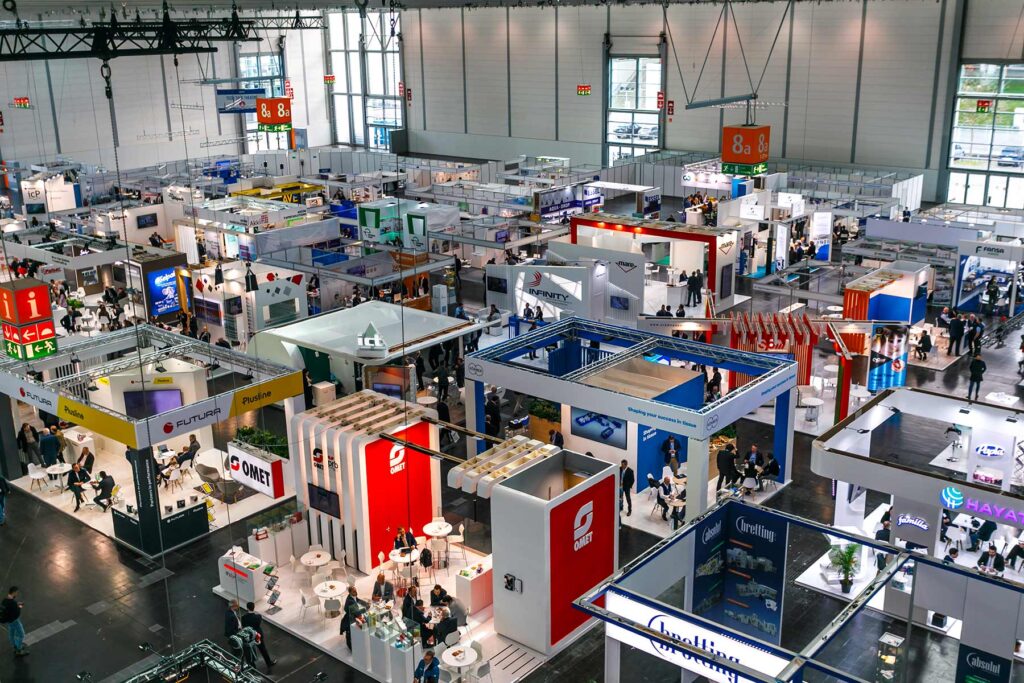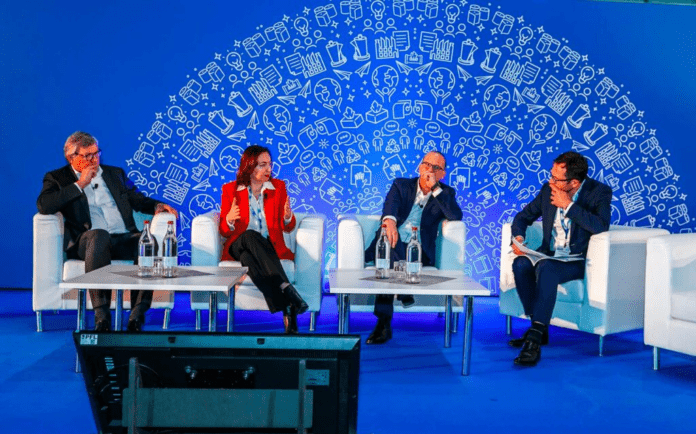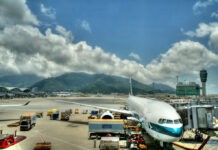Tissue World returned in Europe for the first time in four years with an impressive event that hosted thousands of tissue colleagues for the first time in Düsseldorf. Here, TWM summaries the exhibition and key themes from our AEO Excellence Awards-shortlisted conference
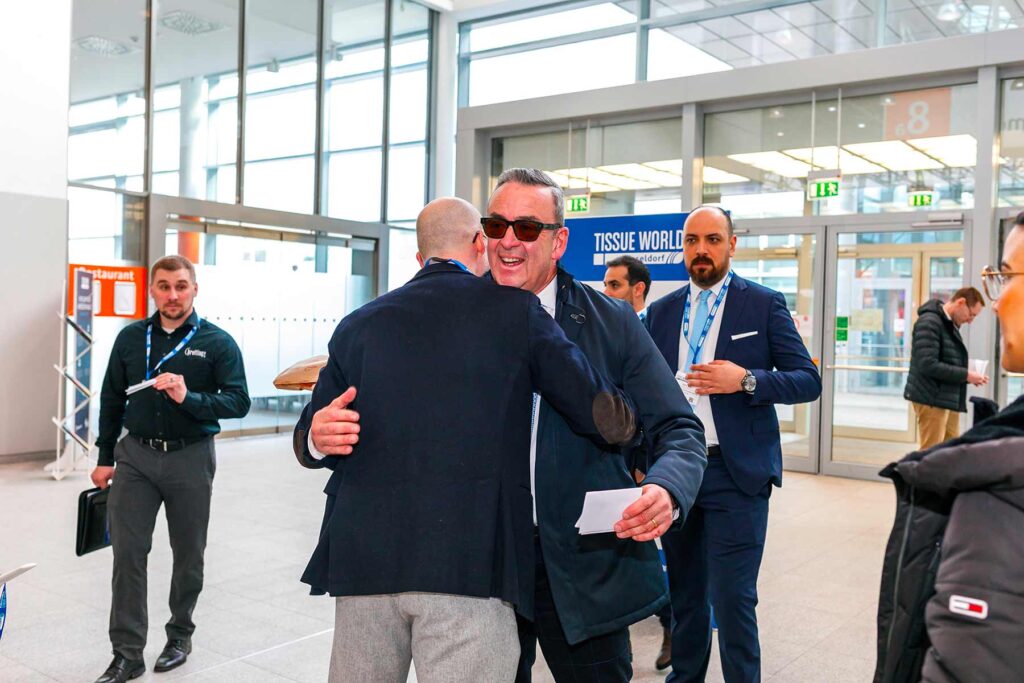
Tissue World Düsseldorf 2023 has successfully welcomed back 2,200 tissue colleagues to the world’s largest tissue industry exhibition and conference – our first European in-person event to be held since the 2019 exhibition in Milan.
Making its much-anticipated debut in Germany, attendees visited from across an impressive 91 countries worldwide.
Some 29% of people were from Germany, 9% from Italy, 6% from the UK, 5% from Türkiye, 5% from Poland, and 5% from Spain.
Several exhibitors also showcased brand new products, including but not limited to:
• Futura – Together 2.0, created by Futura and Plusline to integrate converting and packaging;
• Infinity Machine & Engineering Corp. – launching the Optic M1 poly bundler;
• United Converting Tissue – launching UNICO365 Industrial Logsaw;
• SABA Automation – showcasing its ZEUS P Series and Layer Series automatic robotic end-of-line systems;
• Enerquin – displaying tissue drying technologies and ventilation solutions;
• Microline (D52) – launching Eco Wrap 1050, a multi-pack bundler for folded products and rolls.
Our three-day conference – which was shortlisted for Best International Conference at the Association of Event Organisers Excellence Awards 2023 – discussed how the European tissue industry is at the core of the market’s transformation, and what the future holds.
With a theme of The Roadmap, the Riskmap: Plotting a Course for Tissue in Uncertain Times, the conference included talks by leading executives from tissue mills and machinery manufacturers and panel discussions and Q&A sessions with speakers and visitors.
WEPA Group’s Chief Executive Martin Krengel kickstarted the conference sessions and gave the keynote address: Navigating a European family business in the VUCA world – 2023 as an important year for resilience and sustainable success.
Essity’s President Global Supply Chain Donato Giorgio also spoke, exploring how the supply chain is a competitive advantage in a VUCA world.
Across the technical sessions, the latest technological innovations, operational efficiency, the green energy transition, and future fibres were discussed, including talks from:
• Massimo Bertuccio, Sales Director, Tissue and Robotic Division, E80 Group;
• Bud Chase, Vice President, Tissue, EDT;
• Claudio Muñoz, Sr. Director, Global Strategic Marketing, Körber;
• Matteo Giardini, Business Development Director Plusline, Futura Converting;
• Alberto Colombo, Project and Key Account Manager, OMET;
• Enrico Ruglioni, European Sales Director, Maxima Tissue;
• Luca Linari, Managing Director, Andritz Novimpianti.
Post-pandemic consumer trends and brand marketing were also key topics.
Below, TWM summarises a selection of the key talks.
Challenges and uncertainties ahead
Urban Lundberg, Senior Consultant Strategy, Fisher International
How is the tissue industry doing post-Covid and the ongoing Russian-Ukrainian war?
Surprisingly, we are still functioning and flourishing. The industry is still growing – although at a slower pace. We swiftly adjusted production to meet the extreme shifts in demand, specifically with the Consumer and AfH markets during the first year of Covid-19.
We managed to overcome the energy crisis and subsequent price volatility. And we have been able to find a new equilibrium after supply chain turbulences, hefty costs and price increases.
Are we moving towards over-capacity in Europe?
New tissue machines in Europe have increased in size over the last few years.
There are plenty of challenges and uncertainties ahead and it is increasingly challenging to optimise a sustainable business model
Proximity to market vs sustainability footprint
• Energy price and availability
• Carbon emissions
• Water availability
Fibre supply
• EU initiatives for biodiversity, forest strategy, etc., could eventually lead to reduced wood fibre supply
• Future availability of PfR – will there be enough?
• Strong growth of Eucalyptus pulp. But how sustainable is it really?
• Non-wood fibres such as straw. Marginal or large scale?
There’s a ‘tug-of-war’ for opinion leadership between legislators, producers, traders and consumers.
Sustainability issues which were already prominent have been accelerated by Covid. Following the money – 71% of global fund managers representing $12.9 trillion in assets believe Covid-10 will lead to increase in actions designed to tackle climate change and bio-diversity losses.
Major brands with significant zero carbon initiatives and year of target:
• Apple – 2030
• Amazon – 2040
• Unilever – 2039
• Starbucks – 2050
• Nike – 2050.
Carbon and energy: there are wide differences in carbon emissions amongst European tissue mills – and up to 7x as much GHG emissions for highest emission mills. Nordic mills have a cost–carbon advantage.
71% of the earth’s surface is covered by water but water availability is a growing risk for the European tissue industry, especially in the South. And it is getting worse…
News reports of droughts have dominated headlines, for example in France as it prepares for water restrictions as 2023 drought continues and Spain as it enters long-term drought after another abnormally warm winter.
What does water risk mean?
Risks related to too little or too much water:
• Water depletion
• Interannual and seasonal variability
• Groundwater table decline
• River line flood risk
• Coastal flood risk
• Drought risk.
Risks related to water unfit for use:
• Untreated connected wastewater
• Overfertilisation.
Risks related to uncertainties in regulatory change as well as conflicts with the public regarding water issues.
Half of production is in countries with high water risk. Italy, Turkey, Spain, France and Portugal and Greece are all at high risk. Mills in high-risk countries tend to use less water per ton of tissue.
Water risk mitigation options
Process improvements
• Incremental changes will not likely be enough
Close loop water systems
• Not feasible for white tissue
• Very capital intensive
Use of ocean water
• Requires lots of energy
• Not sustainable
Dry paper process
• Disruptive.
If none of these actions are taken, there is an increased risk for mill closure and relocations.
How can we best handle all this uncertainty?
A few observations from our work with successful companies across the world:
• We are still learning and discovering about the different aspects of sustainability
• No one has all the answers yet
• You need to understand the full picture and various perspectives based on data and insights
• Be willing to challenge yourself and always stay prepared to alter and revise your business model
• Avoid a ‘black-and-white’ mindset. Sustainability may come in a multitude of colours and shades. There is more than one sustainable business model.
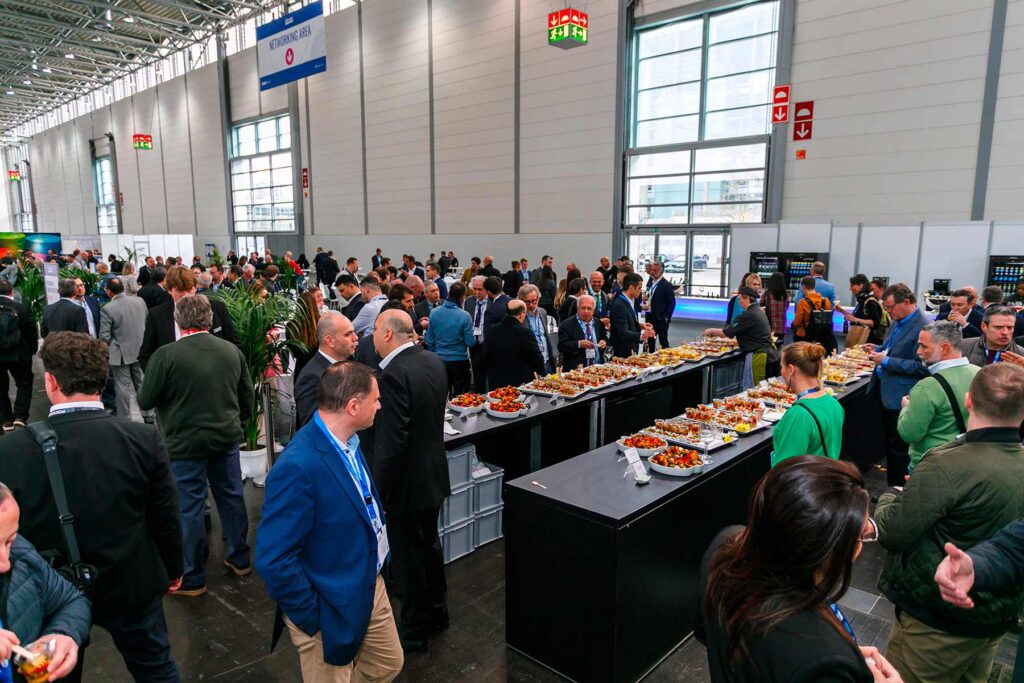
The geoeconomic challenges for 2023:
trends that will define the coming years
Antonia Colibășanu, Chief Operating Officer and Senior Geopolitical Analyst, Geopolitical Futures
Looking at things through the VUCA (volatility, uncertainty, complexity, and ambiguity) lens, we see events in terms of what causes them and what results from them. In light of this framework, action is what determines the future of our business. However, in order to take action and correct potential negative consequences, events must first be comprehended and accepted.
From a geopolitical standpoint, there are two major events that have shaped our reality during the last year. The first and most important was the war in Ukraine, the first military conflict on the European continent that we have seen in decades. Russia’s invasion of Ukraine will likely be remembered as the start of a new era in geoeconomics. The global economic war has begun to shape the world’s economic structure, the uncertainty and tit-for-tat measures kicked off an energy crisis and drastically reduced natural gas exports to Europe.
The second event was the Covid-19 pandemic, which we thought was over but wasn’t. In 2022 we were still seeing China locked down and experiencing ongoing problems with supply chains. China’s Covid zero policy continued to put pressure on global supply chains during the last year and the Chinese economic problems will likely continue to be problematic for 2023.
Yet for years before Covid-19, China, Russia, Iran and North Korea challenged the economic, financial, security and/or geopolitical order that the United States and its allies created after World War II. The era of relentless globalisation had already started to slow or even reverse. The pandemic simply kicked things into overdrive, accelerating reshoring and so-called friendshoring, and depriving developing economies of foreign investment. The global economic war, which began when Russia invaded Ukraine and closed its ports to global trade routes, is further reshaping the world’s trade and investment, as well as the post-Cold War economic system.
Protectionism and global realignment
The war has renewed focus on the growing divide between the West and a nascent revisionist bloc led by Russia and China. It is difficult to see a path back to the status quo antebellum, but several major trends that will define the next decade have become clear.
Crucially for the business world, it also presents the questions of – where does China stand, and what does that mean for us? In the financial markets, the turmoil is not necessarily something we didn’t see coming these past three and a half years.
To show why the financial turmoil isn’t such a surprising event, we need to look at the first event that challenged us. In 2022, it was the major event of Ukraine and Russia. If we look at a map from Russia’s perspective, we can see where Russia’s imperatives come from: its challenging constraints. In the business world, we always consider business risks first – they are stemming from the fears we have regarding our business’ internal challenges, its environment, and its market. That is where we find and learn about our business constraints. In doing so, we map out our business world, considering all things in the “geography” that may change, to the point of threatening our profit margins and our existence.
The map shows that, from its own perspective, Russia was at the point where it was losing ground to the West, to the point of losing influence on its buffer states, and, at the same time, having a complex reality internally, considering the effects of the Covid-19 pandemic. The potential for political turmoil within Russia was therefore high, while the very shaky demographics that Russia has dealt with since the 90s brought no optimism for the Kremlin. All this made the beginning of 2020s very similar to the early 2000s, when Putin came to power. He has since known he’s had to rush if he were to secure himself and Russia some stability. This is why he chose to develop the energy sector and make certain to get Europe dependent on Russian gas – that ensured him of the necessary money to keep Russian internal economics stable while, in theory, Europe would have been obliged to stay engaged with Moscow.
However, Moscow can’t only rely on European energy-related payments for its budget funding – it needs to trade with the world. On the map, while Russia is protected down south by central Asia, the area isn’t supporting much of Russian trade and there’s no easy opening to the world’s oceans. Instead, it is the Southwest of Russia – notably the Black Sea, that provides a key opening to the world’s trade routes. This is why Russia needs to keep its influence in the Black Sea. This is why Crimea and Ukraine are essential for Russia – and why fears of losing influence over their territory quickly transform into major risks, constraints Moscow needs to eliminate. At the same time, because the Black Sea is essential to Russia, its relationship with Turkey is also crucial.
The financial crisis during the last decade and the pandemic have both weakened Russian socio-economics. The West, embodied by the US, NATO and the European Union looked more appealing to states in Russia’s buffer zone, considering their better economic performance than Russia’s translated into better lifestyle for their population, while Russia kept losing influence. So, the Kremlin had to rush to do something to make sure it kept its gateway to the Black Sea and Ukraine under its sphere of influence. All of this provides an explanation for why Russia decided to invade Crimea in 2014 and why it invaded Ukraine in 2022 – just as the pandemic ended and the post-pandemic effects could have brought more pain to the Russians, causing internal instability in the country.
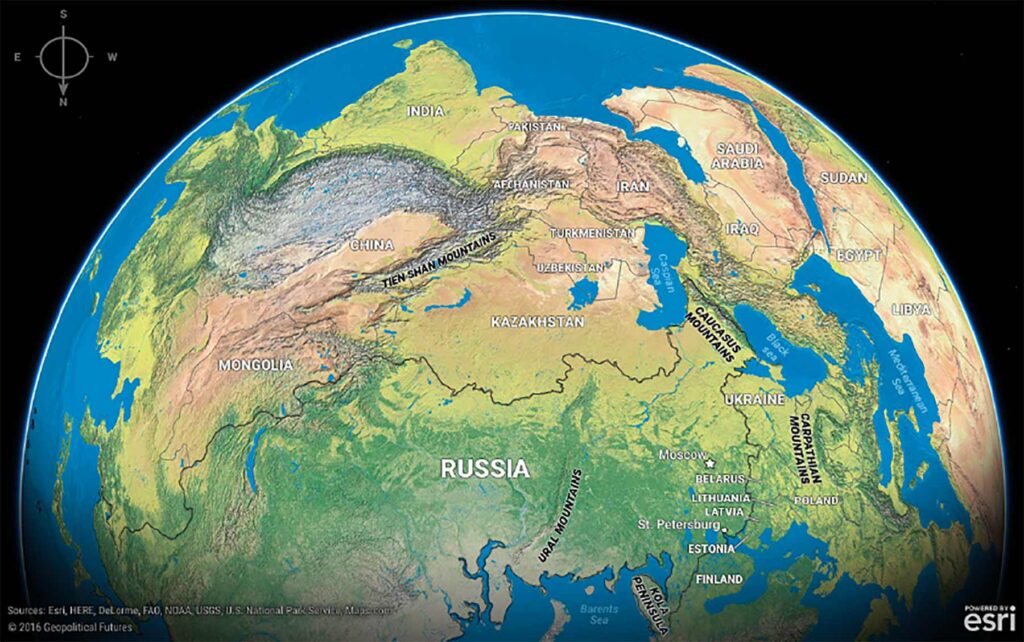
New alignment
The consequences of the war in Ukraine extend far beyond the Black Sea region, with its economic aftereffects hurting both developed and developing economies. Non-aligned emerging countries need to make a choice between Russia and the West – all while trying to make a profit by hedging one against the other while trading with both in an unpredictable, sanctions-affected business environment. In 2022, most of them have put off making a choice between the West and Russia, hoping for a resolution to the conflict that would ease their economic pains. In Europe, a case in point is Hungary, which depends on Russian energy and other commodities to sustain its (fragile) economy and thus is wary of breaking ties with Moscow. It has avoided adopting anti-Russia sanctions and has called for exceptions until it can get alternative sources of energy. Outside Europe, most emerging countries have avoided adopting anti-Russia sanctions altogether.
For most, the conflict between Russia and the West has shaken public and corporate confidence about the near future. In the West, it made it nearly impossible to do business with Russian entities. However, while the mindset about doing business with Russia is changing in the West (and while in Russia it is certainly changing about doing business with the West), neutrality has been the norm for most of the world’s nation-states in 2022. China and India in particular have been taking a very cautious balancing act between the West and Russia, especially in regard to economics.
China: another “geopolitical known”
This gets us from the Black Sea into the South China sea: another “geopolitical known”. China, the main contender and the main partner for the US, holds a key role in the economic conflict between the West and Russia. To understand its reasoning, it is, again, important to check the map. The rising power of the East is not only a continental power (like Russia), but it is also aspiring to become a global maritime power. However, growing its power is certainly not simple for China – it first needs to make sure it stays stable internally, and after the pandemic, China is facing many internal problems.
As important as developments in Europe are, China and its internal stability may be the more consequential economic challenge in 2023. Facing growing protests late in 2022, the Chinese government abandoned its zero-Covid policy with no apparent plan B. It all seemed to work fine, yet media or social media tales of regional economic issues persist.
Enduring weakness of the real estate sector has outweighed positive impulses in other economic areas, and fear of a financial crisis is weighing on private investment. Increasing youth unemployment adds a dangerous element to the mix. Beijing has taken steps recently to solve the real estate sector’s liquidity crisis, but it needs political stability for the measures to be effective. All of this will likely to be a fragile economic recovery for China in 2023.
This is certainly not good news for the world economy. As much as the West would prefer to be sheltered from Chinese events, Europe and the US continue to rely on Chinese industry for critical inputs. Chinese lockdowns hampered supply chains, and the country’s political and economic uncertainty might exacerbate them. Consumption and industrial activity are already declining in the United States and Europe, and there is no end in sight to the energy problem. A crisis in China would exacerbate the situation.
China cannot lose the main market it has, which is the Western world, and in particular the USA. It can’t shift towards Russia because it knows it will have a problem with the US and Europe both. China is in a position where it knows it needs to do something, but it can’t take the risk of going toward Russia because Russia cannot provide a market for its goods. In taking a move, China would want to be on the winning side: if nothing else, it understands that the reconstruction of Ukraine gives it the opportunity of growing its market. All it has to do is make sure it calculates its balancing act carefully, in taking small steps to accommodate hedging Russia against the West and vice-versa. In short, all Beijing can do is wait – until waiting becomes impossible.
India: a very special place in the world economy
India is not as intertwined with the globalised world as China, and it has not developed the types of dependencies that the West and China have. India was this developing market that never quite developed into an economic power: it can’t negotiate its place in the global economic system like China or other European countries can. However, it possesses distinct characteristics that allow it to profit from the current global economic war and eventually (finally) emerge into a significant world power.
Geographically, it is located in a very interesting place in South Asia, and it has an advantage considering its human resource. Over time, it has built a reliance on Asia Pacific while simultaneously strengthening ties with Russia. In many ways, India’s objective was to understand coalitions and find the appropriate partner at the appropriate time. Its strategy is a literal translation of realignment.
What does that mean for the business world? We are talking logistics, corridors, and while we are familiar with the current trading corridor routes from Asia to Europe and Asia to the Americas, most going between the world’s West and East, we are less knowledgeable about potential new corridors between the world’s North and South. To win the war, Russia is looking to develop new corridors – linking the North to the South. In the build-up of such new trade and investment routes, India holds a special place within Russian strategy. However, India is also important for the West – and notably, for the US in pursuing its Asia strategy.
While military and economic agreements are being signed by both the West and Russia (the North) with its partners in the South, businesses need to adapt to the new reality being shaped by the global economic war. With new corridors comes “decoupling”, “reshoring” and “friendshoring”, all of which translate into a whole new business mindset for planning strategy. Businesses (re)learn the geography of the world, as new trade routes appear and as sanctions set off new (invisible) borders between markets.
Using these new corridors, there is potential for countries in Africa to grow its posture beyond a resource-rich continent. Places like Cuba or Venezuela in Latin America, the Fiji Islands in the Pacific are taking new roles, considering both the Western and the Russian perspectives. And each of them, just like India (although less than India) seek their own window of opportunity to negotiate their position, their strategy towards opening for new business opportunities. All these places are where Russia is using tactics to unnerve the West, but also seeking to build up its own alternative logistical supply chain to the existing ones. Something that the West resists – and, on the contrary, helps building its own new alternative trade and investment route.
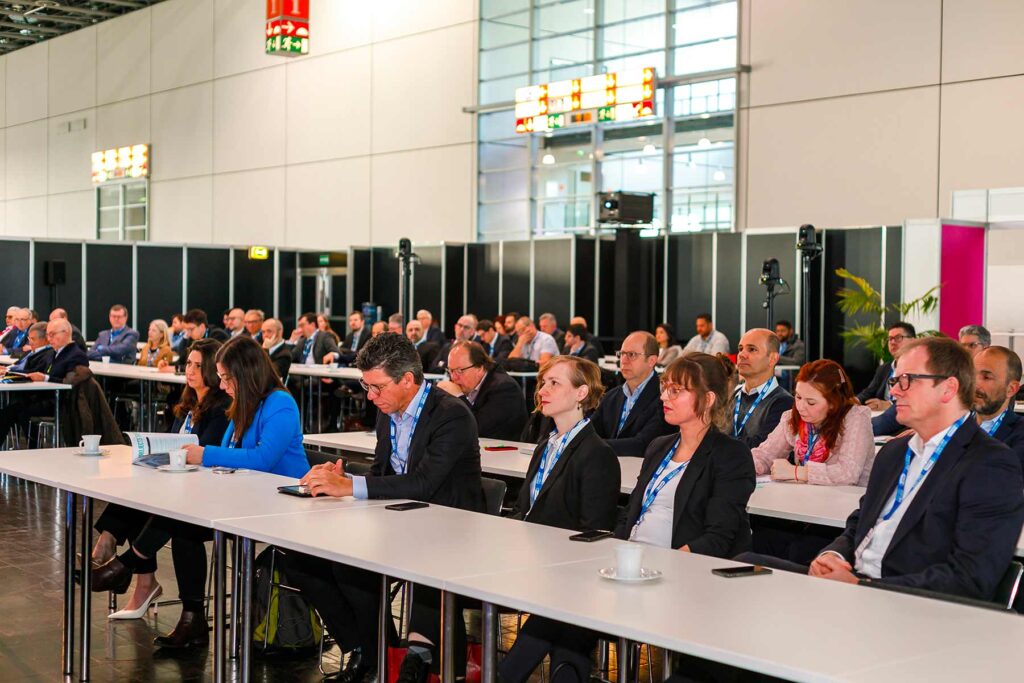
Regaining trust while restructuring the economy
Apart from the grand strategies of the main global powers of the day, what really moves the world of politics and economics comes down to the masses. Changing societies. After the end of the Cold War, we – the individuals, have come to have a different vision to our lives, and this doesn’t necessarily pair with the way politics works (we are disenchanted by our political leadership, no matter the political regime we’re living in). Apart from uncertainty – or fueling uncertainty, individuals hold a lot of distrust into the way their lives are managed, even if they agree with the principles of the way the war is waged. This is true for both West and East, North and South.
This is key to understanding the future. We no longer have usual class-based systems: we the elites, the middle, and lower classes are not “what they used to be”. Instead, due to digitization, we have a more global society with its own layers (instead of classes). Some share the sustainability language and this makes us very urban at the top but also very isolated and very “not-aware” of what is going on with the other layers. Not because we wish to ignore, but because we can’t understand the pains and the fears of the non-urban person everyday life. The nomad settlements in Central Asia and the Middle East, the villages in Africa are far away and disenchanted by our sustainable policies and honest will to better the world we live in. While polarization is growing within all states, it is also growing globally.
The current global economic war will only accelerate this trend. And with it, others will follow. The first is energy transformation. This is very much about raw materials and supply chains, which are very sensitive to the global realignment underway. With increasing polarization, there will be growing regionalization and protectionism. Which essentially means raw materials becoming more expensive. If you don’t have an agreement to get the raw materials you need, you’ll probably have a problem maintaining your industry growing, let alone getting greener faster. Achieving sustainable goals is dependent on our ability to talk to the other – while the other is becoming more of a stranger. In business language, as we begin learning the new geography of the world, building bridges will be key – building trust will be a must for getting things done long-term.
The challenges ahead
If, on the short term, we manage to escape the negative effects of inflation for our businesses. For the first time since the 1970s the world is simultaneously facing high inflation. The drivers of this bout of inflation include excessively loose monetary and fiscal policies that were kept in place for too long, the restructuring of global trade caused by the pandemic, and the sharp spike in the cost of energy, industrial metals, fertilisers and food as a result of Russia’s invasion of Ukraine. Angered by the unequal distribution of the gains of globalisation, voters demanded more government support for workers and those left behind.
However well-intentioned, such policies risk an inflationary spiral as wages and prices struggle to keep pace with one another. Rising protectionism also restricts trade and impedes the movement of capital, limiting improvements on the supply side.
To the extent that the energy crisis is causing high inflation, investment in renewables will mitigate inflationary pressure. Renewable capacity will take time to develop, however, and in the meantime, there is underinvestment in fossil fuel capacity. The latter will take priority.
All that means that we’re likely not going to have to deal with inflation only, but also with growing… “greenflation.” The green transition will require the development of new supply chains for certain metals and will increase the cost of energy generally, creating what’s been termed greenflation. This started in 2019, 2020, with investment not making the mark in terms of green technology. Back then, investors weren’t happy to get into new projects as they feared recession. Now, with an ongoing war, savings become more popular than investment. While companies adapt and prepare for the worst in uncertain times, investing in new green technologies is not a priority.
All this coincides with a rapidly aging population not only in developed countries but also in China and some other emerging economies. Young people tend to produce more, while older people spend their savings and consume more services. And due to the market uncertainty caused by the pandemic and the war in Ukraine, young people are producing less and are reluctant to invest, which translates into a general economic slowdown. Therefore, just as the global economy will continue fragmenting into 2023, so will inflation and greenflation persist.
Major trends and solutions beyond 2023
The major trends in geoeconomics for 2023 and beyond are interconnected. The challenges they pose will require a systematic, coherent approach, but the political leadership in countries around the world is struggling to keep up. The speed of the change requires a different toolset than governments are used to, leaving them trying, and sometimes failing, to adapt to new realities. Cooperation is increasingly difficult, but it has actually grown stronger in some limited areas, like the West’s economic war against Russia following the Ukraine invasion.
Thus, even as deglobalisation (or regionalisation) gains momentum, interdependency isn’t going away completely. Restructuring itself will be a global process. There’s just no avoiding the fact that the world today is interconnected in ways never seen before. Different perspectives will need to be reconciled, and people’s place in society beyond their economic value as consumers and political value as voters will have to be acknowledged. Human behaviour, and therefore state behaviour, is driven by everything from politics and economics to culture and psychology and even technology. This complexity will drive the challenges, and potential solutions, of tomorrow.
The outlook for market pulp: tissue growing in all regions, and is mostly non-integrated
Hawkins Wright
World paper and board production:
022: – 1% (-3Mt) 2013-2022:
• P&W – 4% pa (-42Mt)
• Tissue +3% pa (+8Mt)
• Packaging +2% pa (+30Mt)
• Specialties +2% pa (+2Mt) TOTAL P&B: 0% pa (-1Mt)
• P&W’s share of total production has fallen from 33% in 2013 to 22% in 2022.
World fibre demand by grade:
• Market pulp demand is remarkably resilient
• Tissue is growing in all regions, and is mostly non-integrated
• Virgin fibre displacing RCF at the margin
• Paper production falls in integrated regions (mature markets) and grows in non – integrated regions (EM)
• Consumer restocking during market downturns.
Tissue was the main driver of growth, increasing its share of shipments to 42%. Market pulp shipments growth by grade. Most of the growth has been in BEKP deliveries, symptomatic of the huge investment in low cost, plantation-based pulp mills in Latin America. Most of the growth in market pulp demand has been generated by the tissue industry, which last year accounted for 42% of all deliveries, up from 33% in 2013. We expect tissue to generate an additional 5Mt of shipments by 2027.
Market pulp shipments growth by market
As a fibre scarce country, China has been the main driver of growth in market pulp demand, accounting for 81% of the increase in global shipments since 2013. China now accounts for approximately 36% of the global market.
Chinese pulp projects, 2022-2025
Multiple integrated pulp projects are planned, supported by:
• Government plans to eliminate plastic packaging
• A growing fibre deficit as imports of wastepaper have been eliminated
• Government stimulus
• A revived national quest for self – sufficiency in technology, energy, food and certain raw materials.
Total chemical (BHKP, UKP, DWP) – 5,550Mt
Total HYP (BCTMP/APMP) – 5,130Mt
Total UKP/Semi-chem – 2,400Mt
Total – 13,080Mt
13Mt of pulp capacity planned over the next four years, consuming an estimated 22m BDMT of chips. BHKP, UKP, semi-chem and high yield. Partly replacing OCC (rather than market BHKP). Where will these chips come from?
Chinese pulp production vs. chip imports
China already has a significant dependence upon imported chips, with deliveries totalling 18.5Mt last year, comprising 17.6m BDMT of hardwood and 0.9m BDMT of softwood. 95%+ of these chip imports were used in the manufacture of pulp. Where will China find the wood? Around five million ha of plantations, mostly in the south of China. Only 15% owned by private enterprise.
Battle for fibre in SE Asia
Asian HW chip supply: only Vietnam has grown since 2016. Much of these new pulp lines will be integrated. 10Mt/y of new P&B capacity will start up in 2023 and 2024, compared to an average of +5Mt/y in 2017-2022.
Meanwhile China faces many structural headwinds
• Demographics
• Urbanisation also slowing
• Debt (property)
• Environment
• Geo-politics.
Bleached pulp capacity changes, 2010-2027
Confirmed major projects:
Q1-2023. MAPA 1.5Mt/y BEKP
Q1-2023. UPM Paso De Los Toros 2.1Mt/y BEKP
Q2-2023. Metsa Kemi, 0.8Mt/y NBSK and 0.1Mt/yr birch (net)
Q3-2024. Suzano Cerrado 2.55Mt/y BEKP
(Supply growth to be supplemented by reallocation of integrated supply to the market this year)
Unconfirmed projects: Paracel (1.8Mt BEKP), Eldorado 2 (2.2Mt BEKP), Arauco Sucuriu (2.5Mt BEKP), amongst others. But more closures to come!
Growing challenges in global fibre baskets
News reports have reported on topics such as Indonesian weather agency predictions of a dry 2023, and warnings of forest fire risks, B.C. Pulp and paper sector is in crisis, Portugal’s forest fires burn a third more area than last decade’s average, Brazilian pulp and paper producer Suzano has reported changes in climate conditions which have constrained productivity growth, while Chile wildfires impact pulp production at Arauco and CMPC, trade of logs and lumber in Europe will change dramatically as timber harvests in Central Europe decline and imports from Russia come to a halt…..
Access to sustainably sourced, low-cost fibre dictates the competitiveness of a pulp mill.
• Fibre availability is increasingly vulnerable to the effects of climate change
• Increased incidence of fire, pest, disease, droughts, and flooding.
= costs inflation.
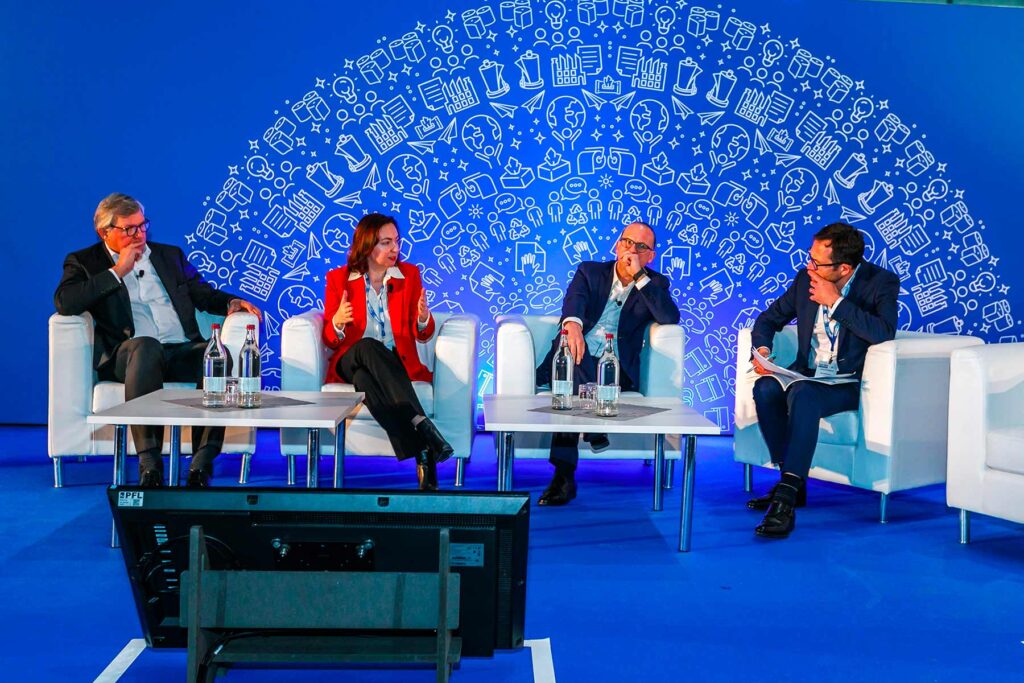
Global Tissue: Post-pandemic and beyond, the changing face of European tissue consumers
Ana Tique, Consultant, Euromonitor international
Geopolitical conflict and inflation exert pressure on demand growth:
• 1% volume growth in 2022, flattening from 2% in 2021.
• 3% – 2022-2027 CAGR value growth to reach USD 103bn in 2027 at constant 2022 prices.
Toilet paper remains dominant, but facial tissues lead the growth. From a subcategory level, each tissue type has a distinct growth pattern moving forward.
Highlights
Home seclusion in 2020 brought strong volume growth globally in toilet paper and paper towels. A natural decline followed it in 2021, as consumers’ home-based cleaning needs decreased considerably when life slowly returned to normal.
Toilet paper remains the largest consumer tissue subcategory. Most of its future growth will come from developing Asia Pacific markets, largely due to growing incomes and a shift to a more urban lifestyle. Despite its size, toilet paper should have a flat, below 2% average value growth over the next five years.
Facial Tissues, on the other hand, are a much smaller category. Many of the gains came from Asia Pacific, too, as boxed facial tissues continued to penetrate low-tier cities and rural markets and are gradually replacing toilet paper, commonly used as a substitute. China plays a central role in facial tissues’ rising regional profile, as local consumers increasingly recognise their health necessity and versatility. This is further manifested in brands’ growing use of functional ingredients and diverse pack sizes that expand indoor and outdoor usage scenarios.
Paper tableware, the smallest tissue category, saw only marginal growth in 2022, with gains attributed almost evenly to low-penetration Latin America, Asia Pacific, Middle East and Africa. Developed regions continued shifting from paper tableware to more cost-efficient, sustainable alternatives such as washable cloths.
World Retail Tissue in 2022
Paper towels remain much stronger in Western Europe and North America, compared with other regions, due to their more common use in home kitchens, consumer awareness and product accessibility. However, both regions reduced paper towel volume consumption in 2022 due to consumer price sensitivity and trade-out.
Facial tissues, on the other hand, find a much stronger market in regions like the Asia Pacific due to increased penetration in low-tier cities and rural markets in place of toilet paper, which has been commonly used for facial cleaning, as well as the staying habit of carrying them out on outings.
Global pressures on consumer tissue demand manifest differently across countries and categories. Amid a backdrop of consumer pricing sensitivity due to inflation and simplified routines, consumers may further reduce non-discretionary spending over the forecast period and sharpen the divide between those seeking value-added attributes and those prioritising low prices. Financially vulnerable consumers will feel most compelled to reduce consumption of products such as facial tissues, typically priced higher and that can be easily substituted with toilet paper, for instance.
This, however, does not suggest the end of premiumisation. In fact, manufacturers will take a divided approach to pursue opportunities in both affordable and ultra-premium segments to address price sensitivity from inflation in the near term and maximise value generation in the longer term.
Digital strategies help companies forge closer customer relationships.
The ongoing promotions and special discounts provided by online retailers have been driving this preference and the convenience of home delivery and ordering from anywhere at any time. Closely followed is the ability to buy products from a larger variety of brands, comparing their features and prices. Another rapidly evolving digital business model in consumer tissue is subscription service, which was already gaining attraction before the pandemic.
Convenience and novelty drive subscription adoption
Convenience, novelty, and personalisation were among the top attractions to get a subscription, which remains the case. In one of Euromonitor’s latest consumer lifestyle surveys, convenience was ranked by 42% of global consumers as the top motivation for choosing a subscription.
The pandemic has fastened the adoption of subscription service, mainly because it offers more stability and predictability during supply chain hiccups.
Sustainable consumerism drives more focused thinking across the product lifecycle
Looking at the industry trends through Euromonitor’s Voice of the Industry Surveys, respondents largely align themselves with the importance of reducing the negative impact of the business on the environment. Companies are aligning with SDGs and other sustainability actions as part of their strategies, bringing better health and wellness components to their teams.
And despite cost pressures, most five-year sustainability plans include the development of sustainable products, sustainable sourcing, and waste management.
The European tissue market: where do we stand?
Price pressure by war and inflation continue to affect demand. Similarly to the rest of the world, the war in Ukraine and record-breaking inflation rates have affected tissue consumption in Western Europe. Consumer confidence reached unprecedented lows in 2022, and despite some early signs of recovery this year, businesses and consumers are still cautious. Although the times are unpredictable, a gradual market recovery can be expected.
Cost of living crisis especially apparent in Western Europe
Very high inflation rates were felt by consumers in 2022 across countries in Western Europe, which reached up to 10% in some cases. In 2023, inflation rates are anticipated to remain high. High prices of food and utilities and a more home-centric life than before the pandemic force consumers to cut out indispensables and trade down where possible in products they still need to purchase.
Private label continues to grow in Western Europe.
The shift to private labels is a viable alternative as consumers seek more affordable options. Private label products’ growing offers and quality are meeting consumers ‘expectations, and as a result, this category has been growing strongly in value and volume.
Western Europe makes up the largest share of top green claims combined.
Western Europe led in claims related to ethical sourcing, such as FSC. “Biodegradable” and “environmentally friendly” claims are also important for the Western European consumer. North America led in more origin-related ingredient claims, such as “from recycled materials”. And Asia Pacific, interestingly, appeared more attuned to clean ingredients such as Natural and No Bleach.
E-commerce gains traction as a tissue sales channel
Similarly to the global trend, e-commerce continues gaining traction in Western Europe as a sales channel. The pandemic years brought the need to develop online shopping platforms on the one hand, and on the other hand, the opportunity for more consumers to integrate this way of shopping into their daily life. Gradually, we could observe how retail e-commerce grew by 2% over the period of 2019 to 2022.
The return to normalcy brought an expected return to brick-and-mortar shopping. Still, over the forecast, the continued growth of e-commerce is expected, motivated by a younger, more digitally inclined client base and more user-friendly platforms, besides advantages such as online discounts and delivery convenience.
As we look forward, three key themes that will be shaping the European consumer tissue industry have been identified that are deeply tied to the consumers’ evolving priorities:
1. The cost-of-living crisis is expected to stay for a while – at least as long as the conflict in Ukraine remains. The continued need to be conservative in spending will, in turn, keep consumers’ motivation to try and become loyal to private-label products, especially if they deliver quality and function for a lower cost. In a nutshell, consumers expect product quality and value for money.
2. An acceleration of e-commerce is expected as businesses shift to digital-based models. More innovation and development of retailers’ online shopping platforms can only keep consumers loyal, and there is less of a need for them to order products from online retail giants.
3. Sustainability aspirations are only growing. Despite the current cost of living prices forcing consumers to wait and see before they spend more for a product that is a better choice for the planet, once the economies and consumer confidence recover, we can expect these concerns to drive the way they shop.
The need to become more responsible and take a more active approach to sustainability has been gaining strength among consumers in the last few years, and the pandemic only made that need more urgent. Companies that act green and communicate transparently can expect loyalty from a growingly environmentally-conscious client base.
Ssangyong C&B launched ‘Tissue gift set’ on KakaoTalk gifts, Korea’s biggest messenger app.
An excellent example of how digital marketing, giftability and online shopping can become drivers of growth in challenging times, such as during the pandemic: Korean brand Ssangyong launched a Tissue gift set on Korea‘s biggest messenger app. There is a tradition of gifting tissues at housewarming parties in South Korea to wish things to “roll well”, like a toilet paper roll. But as Covid-19 intensified over the last years, people have gathered less and less in person.
Through Kakaotalks, people can trade gifts – anything from snacks to luxury goods. This started as an opportunity during seclusion times, but it rapidly became a norm and is likely to be here to stay.
In Euromonitor’s voice of the consumer surveys, the number of consumers that integrate technology into their daily lives was found to keep growing, and they value personalised products.
Pirkka Siivouspaperi by Kesko Oyj in Paper Towels in Finland
Finally, a good example of a private label building on a few products claims that consumers find valuable: Pirkka is a Finnish private label that launched a 3-ply paper towel claiming to be strong, durable, and able to handle scrubbing without piling. It is also FSC-certified and comes at an affordable price point. Innovation, quality, eco-friendliness, and value-for-money align with values that consumers aspire to have and are willing to pay more for.
Conclusion
We are navigating challenging times, and the tissue industry is no exception. Walking into the future, it’s essential to identify high-growth opportunities to focus on. Delivering innovative solutions and value for money is imperative as the consumer becomes more informed and demanding, and the competition tightens with more options in the market.
Finally, transparency and communication are valuable tools in keeping the consumers’ loyalty, providing them with options to be active agents in the global efforts to tackle climate change.
